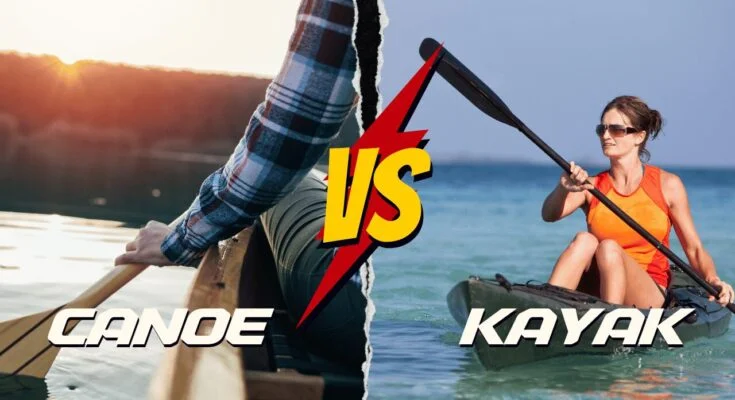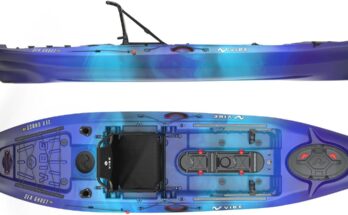If you’re looking to explore the great outdoors on the water, chances are you’ve asked yourself: which is better canoe or kayak? Although both hikes are one of the best ways to interact with nature, they are not the same, which is why they are different: taste, experience, skills and preferences.
To help out we have compiled a comprehensive guide with essential information on the two; canoeing versus kayaking – how are they different? What are the advantages and disadvantages of each and deciding which one to choose next for your next water exploration adventure.
What is the Difference Between a Canoe and a Kayak?
The first general difference can be seen in the type of boats and the strokes they employ, I suppose. Here’s a quick breakdown:
- Canoe: A canoe mainly has an open-top construction with even higher sides and the seats are similar to bench ones. In this type of kayaking, the paddlers either sit or kneel in the canoe, employing paddle equipment containing a single blade to steer and power the boat.
- Kayak: A kayak is a non-convertible or a sit-on-top or offshore boat with a low-rider cockpit wherein the paddler perches on the hips with legs stretched. A person who is kayaking uses a paddle that has two blades and the person switch sides to make a stroke.
Now it is time to reveal the specifics of the key differences that define these two types of watercraft.
Key Differences Between Canoes and Kayaks
Boat Design
Canoes: Canoes are very exposed with no roof that means there can be much room for gears and if it’s a passenger canoe, people, or even food basket. The high sides also shield you from splashes and the elevated sitting position offers you a vantage view of your environment.
Kayaks: Sit inside and sit on top is the two most common categories of the kayak designs exist today. Enclosed cockpits of sit-inside kayak can make the paddler dry and protect from the weather while sit-on-top configurations provide the paddler with more versatility. Mainly, kayaks have low Seakead or the distance of their Internet from water surface which make the boat more aerodynamically efficient and fast.
Paddling Technique

Canoeing: In a canoe you hold a single-blade paddle and move it on one side then on the other side as you wish the canoe to go straight. Canoe – Paddle is mostly a two-man affair so most of the time you will not be alone while paddling the canoe.
Kayaking: A person who kayaks uses a paddle with two blades and paddles on one side then switches sides. This technique facilitates easier and more efficient paddling and so makes kayaking somewhat easier for the beginner to acquire.
Stability and Maneuverability
Canoes: In general, it is easier to balance on a canoe due to its wider structure and this type of vessels is suitable for those who prefer calm water and if you have to take a lot of equipment with you. Nonetheless, these types of boards are not as easy to manage as the soft-top boards especially when the water is current or windy.
Kayaks: A kayak for instance is more slender and hence more maneuverable than a canoe especially when in the small and fast streams. They also enjoy a more centralized CG and that provides enhanced stability, especially while operating under poor weather conditions.
Speed
Canoes: Canoes take longer time because of their size and also they use only one blade when paddling. That being said they are ideal for a slow cruising do not go in them if you want to speed across the waters.
Kayaks: Kaleet are usually faster due to simplicity of design and two part paddle used in this craft. In case covering distance in the shortest time possible is your desire then kayaking.
Capacity
Canoes: One interesting feature of the canoes is that they capable of accommodating a lot of load; that is, they are great to contain other camping accessories such as fishing tools or even another or third traveler. Canoes are the ones that are recommended for those people who are traveling with families or when one is planning on a several days trip when he or she needs more space.
Kayaks: As a rule, to provide the same volume, kayaks must be significantly narrower as compared to sea cockleshells. Normally kayaks are made for one person but there is usually a kayak that is designed to accommodate two people. Although some equipment can be taken into a kayak, they have to be taken sparingly or if not, the items have to be put in dry bags.
The Pros and Cons: Canoe vs. Kayak

To help you decide which watercraft best suits your needs, let’s break down the pros and cons of each.
Pros of Canoeing
- Ample Space: Canoes have a lot of holding capacity for goods, animals, or other people, therefore they are perfect for long journey or several families.
- Stable and Comfortable: The width of canoes provide more buoyancy to the boat while the raised seats are suitable for the longer trips in the bush.
- Great for Calm Waters: Canoes are loved on flat waters like lakes and slower flowing water body of rivers than the fast moving water bodies.
Cons of Canoeing
- Less Maneuverable: Another problem with canoes is the repeatability or steadiness especially while navigating through waters or during windy weather. Experienced paddlers are happy with project alone paddling as it can also be trying at times.
- Slower Speed: Canoes are not designed for speed and hence if you want to traverse long distances at an express rate, then this is not the ideal product to go for.
- More Exposed to the Elements: The main disadvantage of canoes is that they have an open-top; therefore, you feel rain and wind and also can be wet by splashes of the water.
Pros of Kayaking
- Easy to Maneuver: When it comes to maneuvering in small areas, through rough waters or even in rapid currents, kayaks offer wonderful agility to the operator.
- Faster: In most cases, kayaks are faster because of their sleek shape and also since the paddler uses two blades to paddle with.
- Variety of Options: There are recreational kayaks for various purposes starting with general use and going up to the extreme such as whitewater kayaking This makes it more so versatile.
Cons of Kayaking
- Limited Space: Therefore, kayaks have limited space for storing gears and foods hence does not suit people with many gears or group tours.
- More Physically Demanding: Indeed, despite the efficiency of kayaking as oppose to canoeing the constant paddling motion and the lower seating position will pose more stress on your upper body.
- Less Stable: Narrower kayaks can feel less stable as compared to wider ones especially so if you are new in kayaking or you are in water that has waves.
When to Choose a Canoe
You Want to Relax: If what you want is, for example, paddle slowly in order to have a smooth and undisturbed day on the water, or to watch the surroundings or take it easy, nothing is better than a canoe for that.
You Need Extra Space: Canoeing enables one to transport many items in one trip when comparing with single day of camping on a multi day camping trip. It is therefore suitable for families, pets, or fishing trips because of the extra space that is availed.
You Value Stability: Canoes are more stable meaning that if you will be traveling with children or friends who have low paddling skills, a canoe will be best for you.
When to Choose a Kayak
You Want Adventure: For the most adventurous, kayaking is slightly more intense that canoeing, mainly when one is dealing with white water rafting, sea waves or fast flowing rivers.
You’re Paddling Solo: As you will find out on this page, kayaks are also easier to maneuver, which is why if you love adventure and would not want anybody’s company during your exploration, then this could be the best option to go with.
You Prioritize Speed and Maneuverability: Kayaks are the best to be used where high speed and maneuverability are required for instance in narrow water channels, sharp curved river or the deep oceans.
Conclusion: Canoe or Kayak?
While both canoeing and kayaking are both fun water activities, the differences in them are such that a choice between the two depends solely and simply with the kind of experience one wants to have.
Choose a Canoe: These USFs are recommended for those who wish to have a stable platform for a day buoyant on an open water or for those who are going to have multi-day camp that includes lots of bulky equipment.
Choose a Kayak: If you feel more comfortable in a faster and more maneuverable craft, when choosing a boat for spray and storm, or if you want to paddle alone and at the same time feel a hint of adventure.
In any of the two, canoeing and kayaking offer the vantage of viewing nature from water level hence providing an exceptional experience.
Because whether you are surfing in some quiet lake that mirrors your image or you are rowing in some river, the water to is always beckoning you. So grab your paddle, hit the water, and enjoy the ride!




